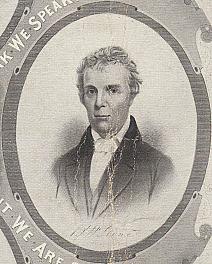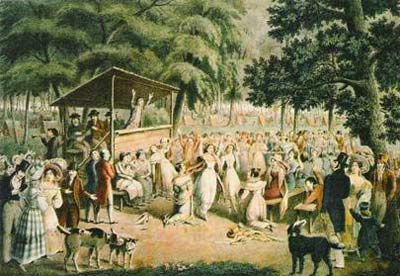One of the events I talk about in my classes is the Cane Ridge Revival in Kentucky back in 1801. That’s the subject of the e-mail I received yesterday from the Christian History Institute. I thought it was well worth sharing.

On Thursday, 6 August 1801, the camp meeting at Cane Ridge, Kentucky finally broke up. Late in the eighteenth century, both pastors and Christian laity in Kentucky recognized the deep spiritual need in their region. Most peopl3 living on what was then the western frontier were indifferent to faith or actively opposed to it.
Christians began to pray for revival. Believing the work of the Holy Spirit would be hampered by neglected sin, many churches purged their membership of individuals who claimed faith but lived in open defiance of biblical teachings.
Revival began in 1800, when a woman who had been seeking assurance of salvation for years suddenly broke into songs and shouts of joy while listening to the exhortations of preacher and evangelist James McGready. Others began to sob and plead for similar assurance. They shared their experience and the news spread like wildfire throughout the state. People hurried to Logan County where McGready was preaching, hoping to share the experience.
Presbyterian minister Barton Stone scheduled a three-day service at Cane Ridge, a day’s ride from the “big city” of Lexington, during the first week of August. Although such services were relatively common, the surrounding atmosphere was now so charged with expectation that there was widespread anticipation of great things from the gathering. Whereas there might ordinarily be hundreds in attendance for such a service, this time thousands came.
Nothing exceptional occurred on Friday, but some campers spent the entire night in prayer. Saturday evening their prayers were answered: a spiritual wave swept the crowd. Preachers raised their voices and urged repentance. Men, women, and children cried aloud. Some fainted. Scoffers mocked. Penitents became hysterical and some began to jerk.

Sunday morning opened with Communion. Afterward, emotion once again swept the crowd under the exhortation of a Methodist minister. Sinners fell to their knees, crying for forgiveness. There were not enough pastors to counsel everyone, so the laypeople counseled one another. The campground was filled with singing, shouting, dancing, groaning and weeping. Some people lay as if dead. With more people arriving and the revival showing no sign of letting up, the leaders extended the services all that night and throughout the following week.
Altogether as many as thirty thousand people—one tenth of Kentucky’s population—made their way to Cane Ridge that week. Hundreds professed conversion. After the meetings ended, their effects persisted. A number of slave owners even freed their slaves. For a year or more afterward, interest in religion ran high in Kentucky. Later, when pleading for revival, Christians would pray, “Lord, make it like Cane Ridge.”
Let me add that the emotions at this meeting led to skepticism in the East about the legitimacy of the revival, so a representative was sent to check out the results. He reported back that he found Kentucky to be the most moral place he had ever seen. We must always look at the fruit to make a sound judgment; in this case, the fruit bore out that this was a work of the Spirit.
